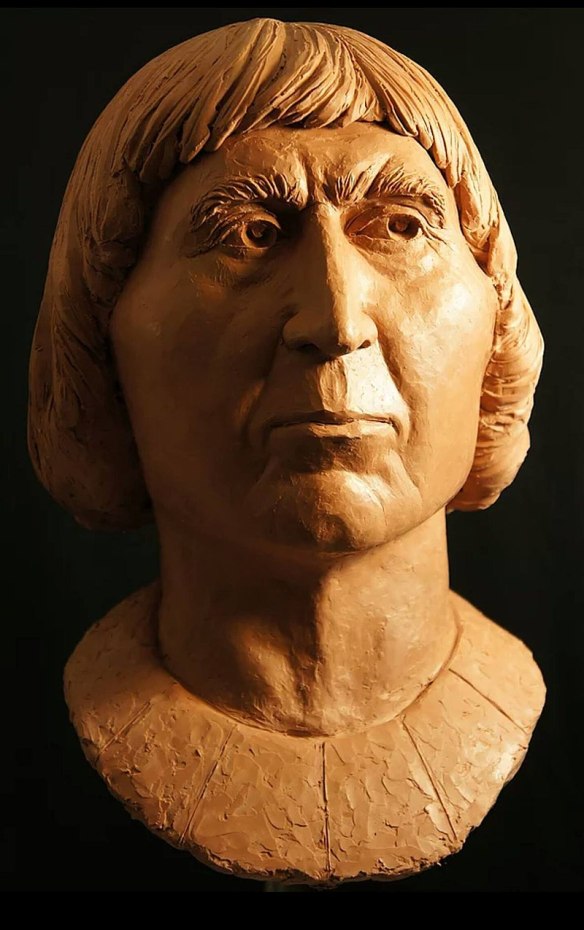The face of Robert the Bruce by forensic sculptor Christian Corbet
Depiction of the Battle of Bannockburn in 1314 from the Holkham Bible
PRINCIPAL COMBATANTS: Forces of England’s Edward I vs. forces of Scotland’s Robert Bruce
PRINCIPAL THEATER(S): Scotland and northern England
MAJOR ISSUES AND OBJECTIVES: Bruce led a Scottish rebellion against English rule.
OUTCOME: Partial eviction of the English from Scotland
APPROXIMATE MAXIMUM NUMBER OF MEN UNDER ARMS: Variable, but Bruce was consistently outnumbered; he may have had 10,000 men at most.
Robert Bruce (1274-1329) was the grandson of an earlier claimant to the throne of Scotland. He had fought on the side of the Scots rebel William Wallace (1272?-1305) (see WALLACE’S REVOLT) but shifted allegiance to England’s Edward I (1239-1307) by 1302. Wallace was executed in 1305, and the following year, although still nominally in the service of Edward I, Bruce defiantly crowned himself king of Scotland at Scone. At this, an enraged Edward invaded Scotland and engaged Bruce’s forces at the Battle of Methven, northwest of Perth, on June 19, 1306. Edward easily routed Bruce’s outnumbered rebels, and Bruce, after a second defeat at Dalry (August 11), fled to remote Rathlin Island off the coast of Ireland. It is said that during his exile Bruce observed a spider weave its web with infinite patience. Somehow inspired by this example, he returned to Scotland in 1307 and quickly found an eager band of followers. He led them against English cavalry at the Battle of Loudoun Hill at Ayr, southwestern Scotland, in May 1307. With arrogant recklessness, English knights charged Bruce’s pikemen and were duly decimated. The defeat at Loudon Hill outraged the aged and infirm Edward I, who, sick as he was with a wasting disease, personally led a campaign into Scotland. However, on July 7, 1307, he died at Burgh-by-Sands, near the Solway Firth. Edward I’s son, Edward II (1284-1327), made a half-hearted foray into Scotland in 1310 but soon withdrew. Bruce used the interlude of peace to mend fences with enemies and to consolidate his forces for operations to clear the remaining English out of Scotland. Often he ventured into northern England on hit-and-run raids.
In 1311 Bruce attacked Durham and Hartlepool, evicting the English from these places, and by 1314 only Stirling, Dunbar, and Berwick remained under English control. By this time Bruce had secured recognition from France and had the backing of the Scots clergy. At this point most historians mark the conclusion of Bruce’s Revolt and the commencement of the SCOTTISH WAR (1314–1328).
10th May 1307 Battle of Loudon Hill
Having rallied his supporters, King Robert was back in business again and came up against his old adversary Aymer de Valence, now Earl of Pembroke, ten miles north of Kilmarnock in Ayrshire. This time the English soldiers were obliged to approach their enemy over bogland, and rapidly fell victim to the spears of Bruce’s men. Over one hundred were killed before the remainder rapidly dispersed.
22nd May 1308 Battle of Inverurie (sometimes known as the Battle of Barra)
King Robert was taken ill on his march north towards Aberdeenshire after his victory at Loudon Hill, but the spring of 1308 nevertheless found him and his army camped at Meldrum, close to Inverurie. John Comyn, 3rd Earl of Buchan, was a cousin of the murdered John Comyn, Lord of Buchan, and determined to bring the King to justice. However, he proved indecisive. Many of his followers had been assured that the King was too ill to fight and when King Robert appeared before them, Buchan’s men turned and fled. Buchan himself escaped to England where he died the same year.
Circa 1308/1309 Battle of the Pass of Brander
This was a conflict between King Robert I and the Macdougalls of Argyll, kinsmen of the murdered John Comyn. There is variance as to exactly where (Brander or Ben Cruachan) and when the incident took place, but it is generally understood that the Macdougalls were caught in a vice between King Robert and Sir James Douglas and put to flight.
Further reading: Christopher Rothero, Scottish and Welsh Wars 1250-1400 (London: Osprey, 2000); Ronald McNair Scott, Robert the Bruce: King of Scots (New York: Carroll and Graf, 1996).
